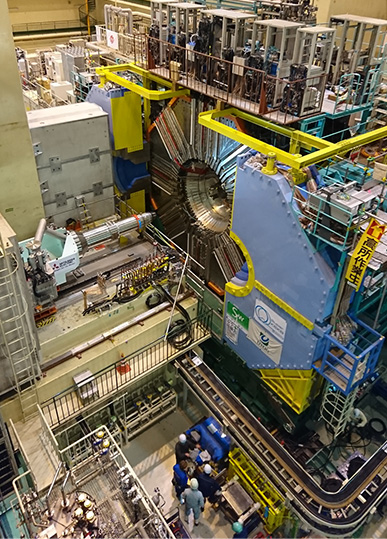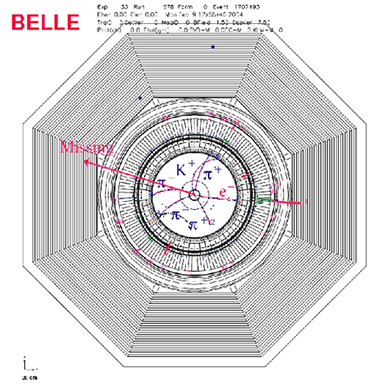The KEKB accelerator is a facility that collides a 8 GeV electron beam with a 3.5 GeV positron beam with high frequency, and generates a large number of pairs of B mesons and their antiparticles, the anti-B mesons. The Belle detector installed at the collision point records the decay process of B mesons precisely. Since the start of the experiment in 1999, the beam intensity at KEKB has increased year by year, with a maximum luminosity of 1.7×1034 cm-2s-1 and the total number of B meson pairs recorded by Belle by the end of 2010 operation exceeded 900 millions. This performance is the highest in the world. N-lab has been conducting front-line elementary particle research using a large amount of data obtained by beam collisions at the highest intensity in the world.
Research
Belle / Belle II Experiment
Research at the Belle II International Collaboration

Our N-lab has been promoting the SuperKEKB / Belle II experiment, which is running at the High Energy Accelerator Research Organization (KEK), as one of the core university groups, focusing on advanced precision measurements in the Standard Model of particle Physics, as well as exploring New Physics beyond that.
The predecessor KEKB / Belle experiment was the world's B-factory experiment, and addressed one of the most important fundamental mysteries in elementary particle physics, including the breaking of CP symmetry in the B meson system (that are differences in the laws of physics acting on particles and antiparticles). The CP symmetry breaking was explained by the Kobayashi Maskawa theory (that was awarded the Nobel prize in Physics in 2008), and N-lab performed various crucial measurements necessary for its verification. Full-scale operation of the SuperKEKB / Belle II experiment with 50 times the KEKB beam intensity began in 2018 to explore physical phenomena with higher accuracy and sensitivity. We will continue to acquire and analyze data after the construction of the instruments that we developed.
World's highest-intensity collider experiment
Research theme

The main research themes at N-lab are the precise verification of the Standard Model of elementary particles using B-meson decays and tau-lepton reactions, the search for new physics beyond that, and the elucidation of QCD physics using hadron reactions.
There are many ways to explore new physics with B meson decays. The B→τν decay, which has been independently investigated by N-lab, is highly sensitive to charged Higgs particles, especially predicted by theories such as supersymmetry. If there exist charged Higgs particles, the decay rate can be different from the value predicted by the Standard Model. However, this decay has been extremely difficult to detect because there are multiple neutrinos that cannot be measured in the final state. We developed a new analysis technique for this decay, and found events interpreted as B→τν decay in 500 million B decay samples. It can be said that this discovery was made possible by the high strength of KEKB and the ingenuity of data analysis. Our results place a strong limit on the mass range in which charged Higgs particles can exist. In addition, N-lab has been conducting measurements of B→D*τν decay, which is highly sensitive to charged Higgs particles, similarly to the B→τν decay.
At the B factory, tau-lepton pairs are produced at about the same frequency as B meson production. Utilizing such a large amount of tau leptons, we have been leading the world in exploring lepton flavor non-conservative decay phenomena. Currently, new physics are being constrained at the world's highest sensitivity level.
In addition, in the B factory experiment, not only B mesons but also c-quark pairs can be generated in large quantities, and a wide variety of elementary particle data can be obtained. We discovered many new hadron states called X, Y, and Z, and provided various information on strong interaction theory in heavy quark systems.
Towards the Belle II experiment
Utilizing a large amount of data obtained in the Belle experiment, we proved CP symmetry breaking in the Standard Model, and confirmed various theoretical predictions with high accuracy. However, deviations from the Standard Model are suggested for some phenomena such as B→D*τν decay. We are conducting a SuperKEKB / Belle II experiment that can acquire 50 times the data of the KEKB / Belle experiment, and perform new physics searches with higher sensitivity.

